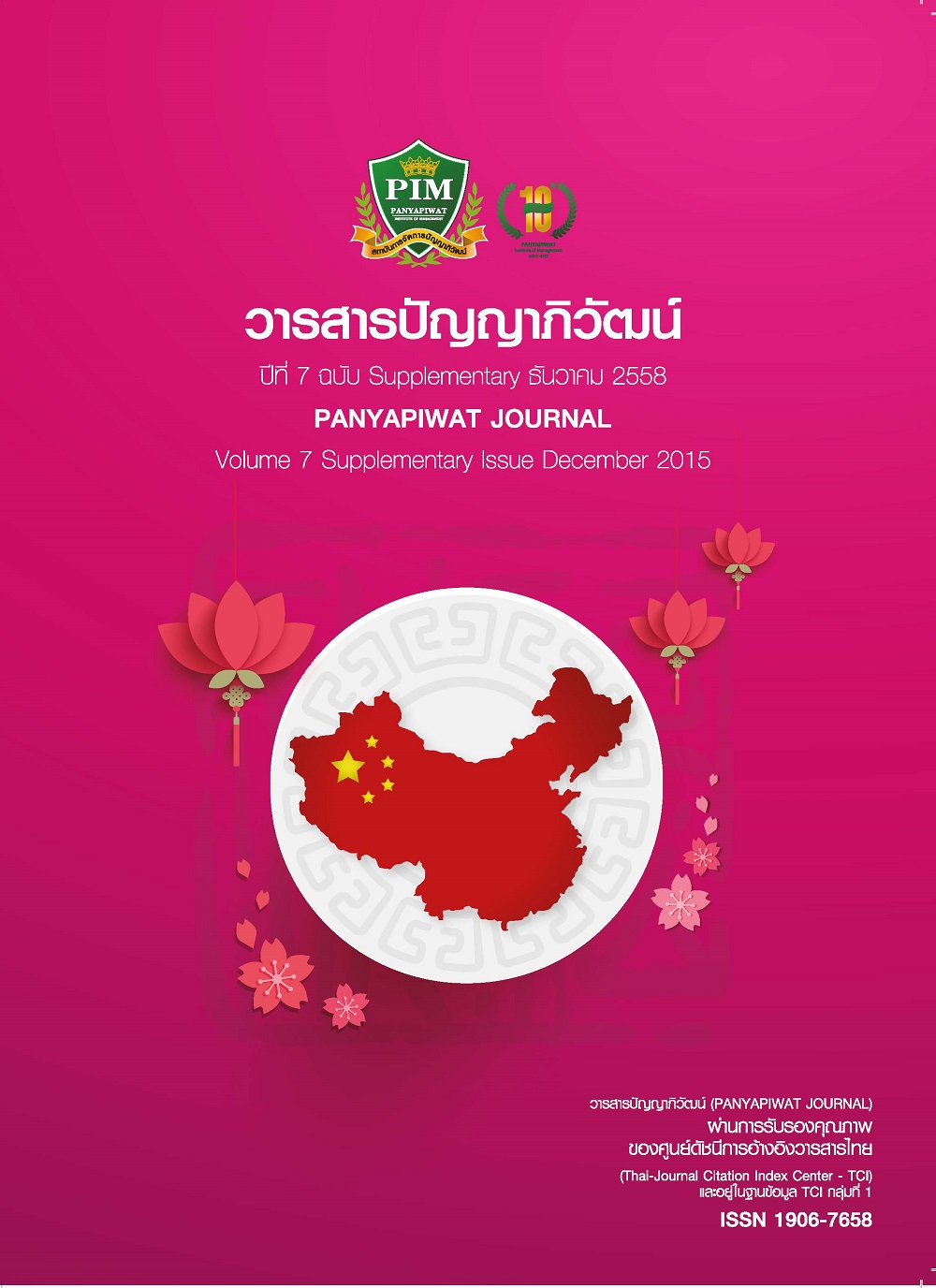泰国华人新移民初创业者企业家精神研究
Main Article Content
บทคัดย่อ
近年来,企业家精神研究已成为管理学界学术研究的重要议题。西方和中国的学者们从多个角度去探讨企业家精神的组成维度及其对创业的重要性。我们在对12位泰国华人华侨新移民初创业案例进行归纳总结的基础上,探索出泰国华人华侨新移民创业者企业家精神的维度。再通过对371人问卷调查因子分析,提出了企业家精神的自信、主动、敏感、坚韧、创新、冒险等六个维度的研究因素, 对于了解和培育泰国华侨华人新移民企业家精神有一定贡献。
One important topic of entrepreneur studies is the dimensions of entrepreneur spirit. Based on the previous case studies of the same authors on the new Chinese immigrants in Thailand, this paper studies the dimensions of entrepreneur spirit of the same target group with survey of 371 entrepreneurs. According to the result of factor analysis, it is found that the entrepreneur spirit of new Chinese immigrants in Thailand has six dimensions: self-confidence, initiative, sensitivity, tenacity, innovativeness, and spirit of adventure. It contributes to the understanding of entrepreneur behavior of oversea Chinese in Thailand and development of entrepreneur spirit.
Article Details
“ข้าพเจ้าและผู้เขียนร่วม (ถ้ามี) ขอรับรองว่า บทความที่เสนอมานี้ยังไม่เคยได้รับการตีพิมพ์และไม่ได้อยู่ระหว่างกระบวนการพิจารณาลงตีพิมพ์ในวารสารหรือแหล่งเผยแพร่อื่นใด ข้าพเจ้าและผู้เขียนร่วมยอมรับหลักเกณฑ์การพิจารณาต้นฉบับ ทั้งยินยอมให้กองบรรณาธิการมีสิทธิ์พิจารณาและตรวจแก้ต้นฉบับได้ตามที่เห็นสมควร พร้อมนี้ขอมอบลิขสิทธิ์บทความที่ได้รับการตีพิมพ์ให้แก่สถาบันการจัดการปัญญาภิวัฒน์หากมีการฟ้องร้องเรื่องการละเมิดลิขสิทธิ์เกี่ยวกับภาพ กราฟ ข้อความส่วนใดส่วนหนึ่งและ/หรือข้อคิดเห็นที่ปรากฏในบทความข้าพเจ้าและผู้เขียนร่วมยินยอมรับผิดชอบแต่เพียงฝ่ายเดียว”
References
蔡振翔,(2002). 试论中国海外移民的共同性与特殊性问题,华侨华人历史研究,第2卷.
陈鸣、贺远琼(2010). 移民创业研究现状评介与未来展望. 外国经济与管理,32卷第8期.
丁栋虹(2010) 企业家精神,清华大学出版社.
李志、曹跃群(2003). 企业家精神研究文献的内容分析,重庆工商大学学报,社会科学版,双 月刊.
林(2006), 社会网络作用于创业融资的机制研究,南开管理评论,4卷,70-75.
王辉耀(2014). 中国国际移民报告 社会科学文献出版社.
杨扬,(2012),企业家精神研究述评,财会月刊,第5卷82-83.
Barney, J. (1991). Firm resources & sustained competitive advantage. Journal of Management,17(1), 99-120.
Baumol, W. J. (1997). Entrepreneurship, Management, and the Structure of Payoffs. Cambridge: Mass. MIT Press.
Casson, M. (1982). The Entrepreneur: An Economic Theory. Totowa: Bames & Noble Books.
Das, T. K. & Teng, B. S. (2000). A resource-based view theory of strategic alliances. Journal of Management, 26(1), 31-61.
Davidsson, P., Low, M. & Wright, M. (2001). Editor's Introduction: Low and MacMillan Ten Years on Achievements and Future Directions for Entrepreneurship Research.Entrepreneurship Theory and Practice, 25(4).
Hane, S. & Venkataraman, S. (2000). The promise of entrepreneurship as a field of research. Academy of Management Review, 25(1), 217-226.
Harrison, R. T. & Leitch, C. M. (1996). Discipline emergence in entrepreneurship: Accumulative
fragmentalism or paradigmatic science. Entrepreneurship: Innovation and Change, 5(2),
-83.
Kirzner, 1. M. (1973). Competition and Entrepreneurship. Chicago: The University of Chicago
Press.
Raphael, A. (1994). Academic Spin-off processes and types of ventures in regions outside high tech clusters The Case of Belgium.
Ray, D. M. (1986). Perceptions of Risk and New Enterprise Formation in Singapore, Frontiers of Entrepreneurial Research. Wellesley MA: Babson College.
Sehumpeter, J. A. (1983). The Theory of Economic Development. Harvard: Economic Studies.
Siropolis, N. C. (1989). Small business management: A guide to entrepreneurship. (7th ed.). Boston: Houghton Miffin.
Steinoff, D. (1989). Small Business Management Fundamentals. (2nd ed.). New York: MeGraw Hill.
Welsh, J. A. & White, J. F. (1981). Converging on Characteristics of Entrepreneurs, Frontiers of Entrepreneurial Research. Wellesley MA: Babson College.
Translated Chinese References
Cai, Z. X. (2002). And the special problems of common Chinese diaspora. Overseas Chinese.History Studies, (2). [in Chinese]
Chen, Y. & He, Y. Q. (2010). Evaluation of immigrant entrepreneurship research and future prospects. Foreign Economics and Management, 32(8). [in Chinese]
Ding, D. H. (2010). “Entrepreneurship.” Tsinghua University Press. 2010. [in Chinese]
Li, Z. & Cao, Y. Q. (2003). Content "entrepreneurship” analysis of the research literature Chongqing Technology and Business University (Social Sciences. Bimonthly). [in Chinese]
Lin, J. (2006). Research on the role of social networks in the mechanism of venture financing. Nankai Business Review, 2006 (4), 70-75. [in Chinese]
Wang, H. Y. (2014). China International Migration Report (2014 Edition). Social Sciences Documentation Publishing House. [in Chinese]
Yang, Y. (2012). Entrepreneurship Research. AND ACCOUNTING MONTHLY. 2012.5 [in Chinese]

